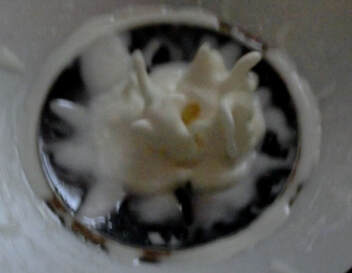|
what you'll need
You'll also want a large washable table or drop cloth if you're working inside, as this can be a pretty messy experiment. Towels and a bucket of clean water are a good idea. prepare your oobleck
Preparing a cornstarch and water Oobleck mixture. experimental procedure
What's happening
There are three main states of matter- solids, liquids and gasses (there is also a fourth state called plasma, and even more states that you may learn about if you study science in college). These three states have very different physical properties, so it is usually very easy to tell them apart. We know that solids keep their shape and are often hard, liquids take the shape of their container but can pour and flow, and gasses can expand to fill all available space. Scientists have created another category (although it's not a true state of matter) called a fluid which includes any substance that will pour or flow if pushed. Liquids like water are obviously fluids, but a bucket of sand or rocks (which are solids) can also be fluids, as can mixtures of solids and liquids, and even gasses. But what if a material has properties that fit with more than one state of matter at the same time? We're not talking about cooling a liquid until it freezes and becomes solid, or boiling it until turns to gas- all substances act this way depending on their temperature. Oobleck can act like a liquid- it takes the shape of its container, it's easy to stir and you can pour it- but if you push it too hard or too quickly it instantly acts like a solid- it stops flowing, keeps its shape and can even break. So is Oobleck a solid or a liquid? The answer is both- and neither. Confusing, right? It turns out that not everything easily fits into just one state of matter category. Oobleck is a fluid because it can flow, but it's certainly not like water or other normal fluids, so we call this a Non-Newtonian fluid (named after the famous scientist Sir Isaac Newton). Scientists aren't exactly sure why Oobleck acts this way, but the full explanation below will help you understand what might be happening. There are many other common substances (like ketchup or toothpaste) that also have some strange properties if you study them closely. You can find out more about these in the related activities and links below. More detailed explanation
When a large amount of cornstarch is added to a smaller amount of water it does not dissolve to make a liquid solution. It can flow, however, so we refer to this mixture as a fluid. A fluid is not a phase or state of matter (such as a solid, liquid or gas) but rather any substance that will deform or flow when a shear stress (i.e. a sideways push or force) is applied. If you pour some water onto a plate to form a small puddle then lift one edge slightly, the water will slide or flow along the surface of plate due to gravity. The term fluid and liquid are often used as synonyms, but a fluid can actually be liquid, gas, mixtures of either or both, mixtures of solids in a liquid (called suspensions or colloids), or even mixtures of two or more solids. Examples include sand, rocks, honey and maple syrup. If it flows as a shear stress is applied- even very slowly- it can be considered to be a fluid. Many materials thought to be solid- such as glass or tar pitch- will actually flow very slowly, often taking years for any noticeable change to occur. Most common fluids flow faster as higher shear stress is applied- i.e. the harder you push (or the more you tip a cup) the faster it flows. Resistance to movement or flow is called viscosity- a fluid with low viscosity will flow easily even under very low shear stress (an example is water), while a highly viscous fluid flows very slowly (such as honey). If the flow rate or viscosity is simply proportional to the stress and stops flowing when there is no stress, the substance is called a Newtonian fluid (after Isaac Newton, who first studied them). Oobleck, however, is an example of a (very) non-Newtonian fluid. Its flow rate decreases dramatically (i.e. the viscosity increases dramatically) as the sheer stress increases. The harder and faster you push or pull on the Oobleck, the more viscous or solid-like it becomes. You can even run across the surface of a large pool filled with oobleck (check out the video links below), but if you stop you will sink. This specific type of non-Newtonian fluid is called a stress thickening or dilatant fluid. More advanced dilatant materials are now being used in protective gear for football and other impact sports. The pads flex and move easily under normal motion, but when subjected to a sudden blow (a hit or tackle) they instantly stiffen and absorb the force of the impact, protecting the athlete. Bullet-proof vests are also being developed with these materials. To understand what is happening inside the Oobleck, picture the cornstarch molecules suspended or floating around in the water. As long as little or no stress is applied, the cornstarch molecules are free to move easily (sort of lubricated by the water), sliding over and around each other. However, when a large or sudden force is applied the solid cornstarch molecules instantly clump or stick together (flocculate) and the entire matrix acts like a solid. There is so much more cornstarch than water in the mixture that there is just no room for the cornstarch molecules to quickly move. If the mixture is made with a much higher proportion of water, however, this behavior is not observed, even though the fluid may still be thicker and more viscous. This is what happens when you use cornstarch to make gravy or pudding. Oobleck Cornstarch Monsters (find out what's happening in the Related Activities below) variations and related activities
One of the most interesting things you can do with Oobleck is to vibrate it (move back and forth) very quickly, typically by placing it in a speaker cone and driving it with a frequency generator and amplifier (as shown in the video above). Once we start the amplifier the cone vibrates back and forth between 50-90 Hz (cycles per second) which pushes on the Oobleck as the speaker moves forward, causing it to solidify instantly. As the cone stops and then reverses direction the Oobleck can relax and become liquid-like once again. These solid to liquid transitions occur so quickly that the Oobleck is able to build solid-like fingers and other shapes that seem to grow and come to life right out of the liquid. Some even break free to hop and dance around. Watch the behavior change in the video as we vary the frequency and amplitude of the vibration. There are many other interesting and very different types of non-Newtonian fluids. If the viscosity decreases as the stress increases, the fluid is called a psuedo-plastic or stress thinning fluid. Latex paints (as well as some nail polish and cosmetics) are designed to have psuedo-plastic behavior- you want the paint to flow easily off the brush when it's moving, but stop flowing once it's on your wall. Another example is toothpaste. Put a small amount of toothpaste on an electric toothbrush. As long as it is turned off, the toothpaste behaves like a solid and does not flow, but as soon as you vibrate the toothbrush the toothpaste will begin to flow and even dance around. Another example of a non-Newtonian fluid is the slime or silly putty, like we make with Elmer's Glue and borax in one of our other popular activities. While the actual behavior is rather complex and difficult to categorize, it will flow fairly easily (i.e. act like a liquid) under low stress, but break (like a solid) if too much stress is applied. Jell-O has somewhat similar behavior. It is also possible for the viscosity to change with the duration (rather than the magnitude) of the applied stress. If the viscosity continues to decrease over time as a constant stress is applied (even if it's relatively small in magnitude), the fluid is said to be thixotropic. Ketchup or tomato paste is an example of a thixotropic fluid [actually ketchup is even more complicated, exhibiting both thixotropic and pseudo-plastic properties]. Remember the Hines Ketchup commercial (to the soundtrack of Carly Simon's "Anticipation")? To help pour ketchup out of the bottle you should shake or vibrate it quickly, the viscosity soon drops and the ketchup flows more easily (see the video link below). Another odd but difficult to categorize non-Newtonian fluid is quicksand (fine sand particles suspended in water). When quicksand vibrates (such as during an earthquake or someone stuck squirms around) water flows around the sand particles and makes them more buoyant (a process called liquefaction), decreasing the apparent viscosity. When this happens a building or person on the surface can easily sink into the quicksand. When a person is trapped in quicksand, however, his movements can create local regions where the water flows away and the sand particles are compacted into a solid. Thus the quicksand actually has a very complicated behavior. To escape from quicksand, simply relax and move very gently and slowly. Because the sand/water fluid is much more dense than your body, you will literally float to the surface over time, rather than sinking to your death as is always portrayed in the movies. Yet another strange fluid is a mixture of cornstarch in vegetable oil (such as corn or canola oil). Prepare a much less viscous mixture (about 2 parts cornstarch to 1 part oil). It should pour easily from one cup to another with the consistency of pancake batter under normal conditions, but if a strong electric field is present the viscosity will increase dramatically. This is an example of an electro-rheological fluid. To demonstrate this, rub a balloon on your shirt or in your hair to create trapped electric charges on its surface (sometimes called static electricity). As a partner slowly pours the cornstarch-oil fluid from one cup into another, carefully bring your charged balloon near the pouring stream and the fluid will not only bend towards the balloon, but will actually stop flowing and "freeze" in mid-air. Remove the balloon and the stream will begin to flow again immediately. Materials with this property are being used in some automotive transmissions, clutches, brakes and shock absorbers. references and links to more information
More on Non-Newtonian fluids [Note that as you read more about Non-Newtonian fluids you may find a lot of contradictory information. This is because the behavior of these materials are often very complex and difficult to categorize]:
More activities and videos with Oobleck:
Running across a pool filled with Oobleck: More Oobleck Cornstarch Monsters:
Why is Ketchup so hard to get out of its bottle?:
Electro-rheological and magneto-rheological fluids:
0 Comments
Your comment will be posted after it is approved.
Leave a Reply. |







